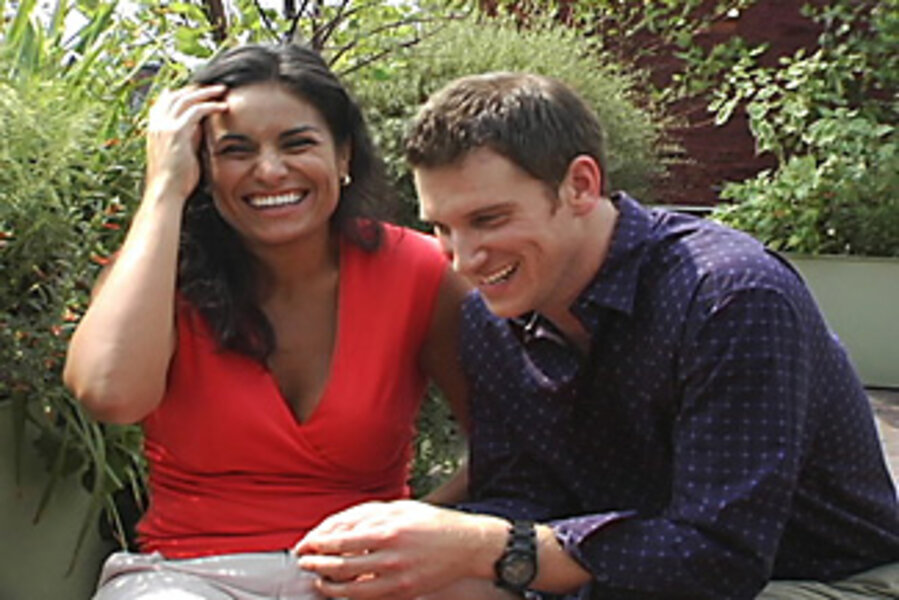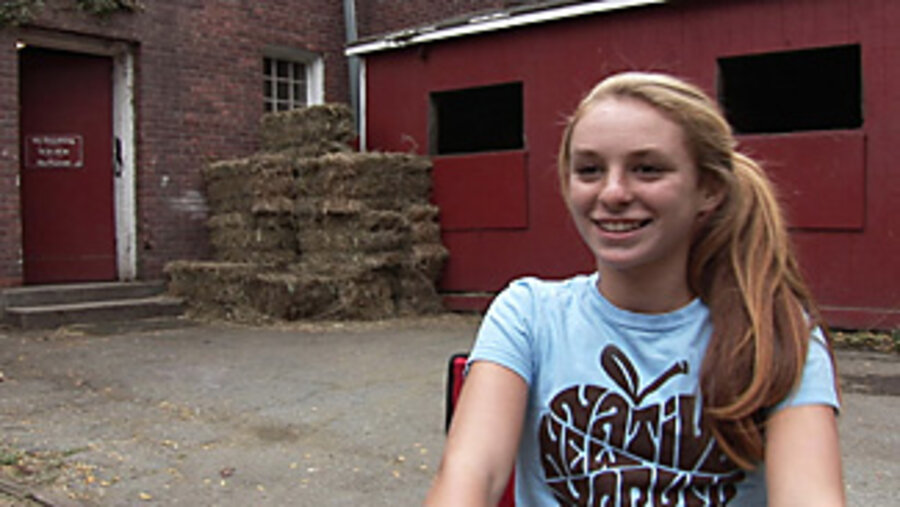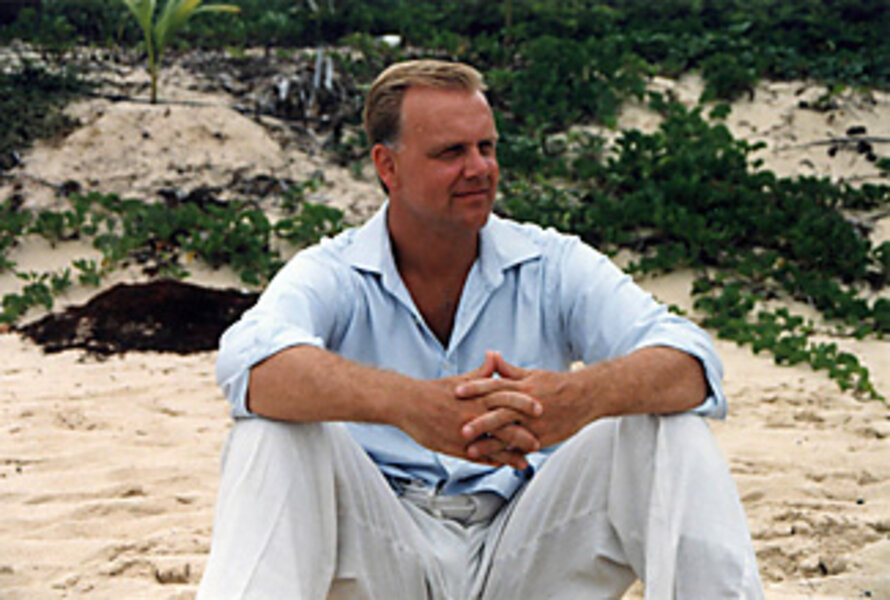In professional 'personal documentaries,' memories polished – and preserved
Loading...
| New York
In a dimly lit room on the edge of Chelsea, the fragments of Tiana Schlossberg's life are being cobbled together, piece by piece, like a Technicolor puzzle. There are the vacations and the downtime with friends. There are baby pictures and video clips and a handful of other glossy, celluloid memories.
"It's a lot of moving parts," says Peilin Chou, tracing her hand over the computer monitor. "It can be challenging – we're looking for that one sound bite."
Ms. Chou, and her partner, John Brancaccio, are veterans of television and film production. Their résumés include stints for MTV, Fox, ESPN, Bravo, Spike, Nickelodeon, and, in Mr. Brancaccio's case, a pair of feature documentaries shot in Africa. But today their project is small in scope and decidedly more intimate. They're here to put the finishing touches on a film about Tiana's life that will be shown at her bat mitzvah celebration just a few days away. For Tiana and her family, the 15-minute portrait is a way to mark this milestone, her passage from childhood to adulthood.
Searching for something more polished than a home video, individuals and families are commissioning professionals to film and edit personal documentaries with a mind to screening them at bat mitzvahs, birthdays, weddings, and even funerals.
Advances in affordable video technology have made it so that just about anyone can wield a camera and, with the help of a desktop editor, splice together a personal story. But the easy availability of these tools seems to have underscored the value of expert guidance. Companies like Chou and Brancaccio's Lifefilm Productions are helping customers (who can afford their services) produce well-told stories.
Stories, they hope, that will hold up for viewers outside the family.
"Because everybody can do it, nobody does it well," says Federico Muchnik, director of the film program at the Center for Digital Imaging Arts at Boston University. "It's incumbent now upon the craft people to sculpt: to use their craft – lighting, sound, storytelling – to make a compelling movie."
Photo montages and even short films, often with a comedic bent, are staples of the New York bar mitzvah circuit, says Tiana's mother, Zena Saunders. She was looking into making a montage for her daughter's bat mitzvah when she came across Lifefilm.
"They're so different," says Ms. Saunders, whose daughter was angling for something humorous that would appeal to her peers. "Instead of just being the typical slapstick script kind of material, it was more of a personal, family experience film – more documentary-ish. I figured if I was going to do something to mark the moment, I wanted it to be more than slapstick."
To make Tiana's video, there were interviews with her sister and parents and with both sets of grandparents. There was a day of shooting her with her horse, Macy, at a stable outside the city. (The theme the family settled on, in consultation with Chou and Brancaccio, was "life lessons," centered on what Tiana has learned as an equestrian. Her mother agreed to a short introductory skit with Tiana and Macy to insert some humor into the film.) There was a flurry of e-mails, back and forth, between Tiana's mom and her editors. There was a rough cut. And finally, after five months, Tiana's film was ready.
The impulse to commemorate seminal moments, of course, isn't new. It's the tools that are changing.
"People are making life-transition videos for the same reason they used to make scrapbooks," says Patricia Aufderheide, author of "Documentary Film: A Very Short Introduction." It's a chance to "leave and make memories and thus extend the life of the person and event. "
As with bar mitzvahs, slide shows set to music – documenting the journey from infancy to engagement – have come to be a regular part of weddings. They are the most popular video that Lifefilm, created in 2006, produces. In the past few years, the numbers of this type of film, sometimes called "love stories," have doubled, says Dan Argenas, communications director for Wedding & Event Videographers Association International.
Professionals don't come cheap, though. The cost of a Lifefilm begins at about $5,000 and can easily reach into five figures, depending on length and complexity. At Boston University, Mr. Muchnik says he tries to teach students to gauge what clients can pay. "Usually anything under $1,500 isn't worth anyone's time," he says.
There are some less expensive alternatives available. Bruce Merwin, a professional cinematographer in Coral Gables, Fla., creates personal documentaries starting at $600. "I'm probably way under where I should be," he says. "But the thing is, I'm a one-man band."
Mr. Merwin sees himself as a sort of historical iconographer, like a contemporary cave painter. "I can scratch out these people's lives in a cave so that many, many moons from now, others can step into the cave and see what [life] was like."
It's the same desire, to capture a life on film for loved ones, that led Tyler and Brent Cassity to create LifeStories. In 1989, the brothers, who own cemeteries in Missouri and California, began setting photos to a soundtrack and screening them at funeral services.
Today, through their company Forever Enterprises, they also offer the more elaborate LifeStories, divided into seven-to-10 minute chapters that start at $395. The longest film that Christina Geisen, a senior editor for LifeStories, has worked on was 15 chapters. It took up two DVDs. "But I watched a little of it today, and it's still interesting," she insists.
The time and work that goes into these films is intensive. "In any given interview," says Lifefilm's Brancaccio, "75 minutes [are] whittled down to, say, one minute."
Asked if she might have cobbled together something on her own, Saunders, who provided the Lifefilm team with 40 DVDs' worth of home movies, seems stunned. "Never," she gasps.
Less than a week after Tiana's celebration, where Saunders says the video was a hit with parents, she was already looking ahead to the next bat mitzvah and an accompanying Lifefilm for her youngest daughter. Thankfully there's still time – about four years – to collect footage.
• Matthew Shaer contributed reporting from New York.








